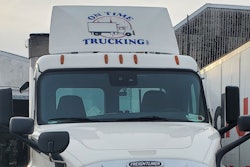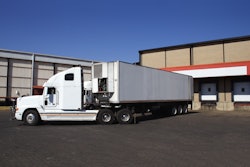As lingering weakness in freight market conditions continues, it’s interesting to see carriers showcase resilience and navigate a tough climate.
From setting the stage for future growth through gradual acquisitions, to deploying capital efficiently by reinvesting back to the business, carriers ended the year by gearing up to capitalize on potential opportunities.
Take a look at the rundown on the earnings of major publicly traded carriers below.
Covenant takes slump in revenue
Covenant’s (CCJ Top 250, No. 43) total revenue in the last quarter of the year ended with a 7.4% year-on-year decline of $273.9 million. The carrier noted weaker freight conditions in the truckload market, despite strategic planning that yielded positive results, said David Parker, Covenant chairman and CEO.
The carrier’s asset-based segments contributed approximately 67% of total revenue, 74% of operating income, 63% of total freight revenue, and 76% of adjusted operating income in the quarter. While asset-based segment’s total revenue declined, Parker noted that adjusted operating income “remained comparable” as a result of improved uptime and utilization with newer equipment and cost savings measures that was executed by the team.
Asset-light segments, which contributed to approximately 33% of total revenue, saw year over year declines in both revenue and operating income. This was primarily driven by the carrier’s managed freight segment, Parker said, which experienced significant reductions in both revenue and profitability with little to no project related freight in the current quarter.
Parker added that the carrier’s warehousing segment was able to grow revenue through new customer startups and improve margins with contractual pricing increase put into place throughout the year.
Revenue: 2023 Q4: $273.9 million vs. 2022 Q4: $296 million
2023 YTD: $1.1 billion vs. 2022 YTD: $1.2 billion
Income: 2023 Q4: $12.7 million vs. 2022 Q4: $11.5 million
2023 YTD: $55.2 million vs. 2022 YTD: $108.6 million
-
Forward Air Corporation indicates wins and losses amidst merger
Forward Air Corporation (No. 34) saw revenue dip 16% year-over-year in Q4, with full-year revenue down by 18.4%. Net income took a dive from Q4 at $14.7 million (a 138% decline), compared to last year’s net income of $39 million.
The carrier completed the acquisition of Omni on January 25, over three months later than planned. The delay was caused by issues such as receiving backlash from investors and court disputes, and has led to the departure of the CEOs from both organizations.
Michael Hance, interim CEO, addressed that continued challenging market conditions led to decreased customer demand for its intermodal and truckload brokerage services throughout the fourth quarter.
Despite weak freight conditions, he also noted that the carrier’s revenue growth strategy led to positive volume trends and improved freight quality metrics. The carrier’s free cash flow saw an increase of 12.5% in the quarter at $49 million, compared to 2022’s Q4 at $43 million.
Revenue: 2023 Q4: $338.4 million vs. 2022 Q4: $403 million
2023 YTD: $1.3 billion vs. 2022 YTD: $1.6 billion
Income: 2023 Q4: $(14.7) million vs. 2022 Q4: $39 million
2023 YTD: $42.8 million vs. 2022 YTD: $179 million
-
Heartland Express’ acquisitions brings all-time record of high annual revenue
Heartland Express (No. 28) capped off the year with mixed results – it achieved an all-time record of operating revenue of $1.2 billion in 2023, up 25% from 2022, whilst its net income took a dip of 89% from 2022 at $14.7 million.
The Iowa-based carrier’s operating ratio for its acquisitions Smith Transport and Contract Freighters Inc. settled in at 103.8% for the year, though in the first nine months of 2023, operating ratio was at 101.6%.
The results reflected the “continued weak freight environment,” said CEO Mike Gerdin, with acquisitions “pressured our financial results to a level below our historical results and management expectations.”
The carrier is optimistic in its long-term outlook, and is using its additions to expand its real estate portfolio of terminal location. It reduced its debt levels to $300 million, following $114.1 million in debt payments during the year.
Revenue: 2023 Q4: $275.3 million vs. 2022 Q4: $354.9 million
2023 YTD: $1.2 billion vs. 2022 YTD: $967.9 million
Income: 2023 Q4: $5 million vs. 2022 Q4: $15.4 million
2023 YTD: $14.7 million vs. 2022 YTD: $133.5 million
-
J.B. Hunt plummets further
J.B. Hunt (No. 3) saw a decrease in both quarterly and annual revenue and earnings – the fourth quarter revenue fell to $3.3 billion, a 9% decrease from the previous year, whilst operating income went down to $203.3 million, down 28% year-over-year.
[Related: J.B. Hunt president taking on CEO role]
Total revenue took a 13% dip of $12.83 billion, and full year operating income took a 25% decline at $993 million.
“We remain long-term focused and we’ll continue to do so while being disciplined in our approach,” said CEO John Roberts, citing the decline to shrinking volume across its segments and rising insurance costs.
Revenue: 2023 Q4: $3.3 billion vs. 2022 Q4: $3.64 billion
2023 YTD: $12.83 billion vs. 2022 YTD: $14.8 billion
Income: 2023 Q4: $203.3 million vs. 2022 Q4: $281 million
2023 YTD: $993 million vs. 2022 YTD: $1.3 billion
-
Knight-Swift Transportation’s third-party insurance business takes a bite out of total income
Knight-Swift (No. 5) ends the year with a total revenue of $1.9 billion, which is a 10.8% increase from the same period the year before. Its operating income reflected a dip of 91.0% at $18.3 million. It also reported a 58.7% decline in operating income in its truckload segment, echoing the industry’s difficult environment.
“The full truckload market capacity oversupply, coupled with customers’ efforts to reduce inventory levels have contributed to a difficult operating environment,” said CEO David Jackson.
[Related: Knight-Swift president stepping down]
The Phoenix-based carrier reported a $71.7 million operating loss in its third-party insurance business, which impacted its adjusted earnings per share. The company is exiting from that business and plans to conclude third-party insurance operations by the end of the first quarter of 2024.
Revenue: 2023 Q4: 1.9 billion vs. 2022 Q4: $1.7 billion
2023 YTD: $7.1 billion vs. 2022 YTD: $7.4 billion
Income: 2023 Q4: $18.2 million vs. 2022 Q4: $202.5 million
2023 YTD: $338 million vs. 2022 YTD: $1.09 billion
-
Landstar feels the brunt of previous freight cycles
Landstar’s (No. 7) performance reflected the continuation of soft freight demand felt in the industry. Its revenue took a plunge to $1.204 billion, down from $1.675 billion in the same quarter of the previous year, citing a weaker than typical peak season.
The carrier’s segments, including van equipment, unsided/platform equipment, power only, and less-than-truckload, all faced a decline in revenue during the quarter. It attributed that a loose truck capacity market contributed to a 22% decline in the number of loads hauled via truck, and a 10% decrease in truck revenue per load compared to the fourth quarter of 2022.
“Landstar’s revenue performance through the freight cycles that occurred over the past four years ultimately set the stage for where we are today,” said CEO Jim Gattoni on a conference call with investors and analysts on February 1.
Revenue: 2023 Q4: $1.204 billion vs. 2022 Q4: $1.674 billion
2023 YTD: $5.3 billion vs. 2022 YTD: $7.4 billion
Income: 2023 Q4: $74.6 million vs. 2022 Q4: $124.3 million
2023 YTD: $344 million vs. 2022 YTD: $571 million
-
Marten Transport’s operating expenses rises
Marten Transport (No. 37) saw its revenue and income come in weaker in both the fourth quarter and the full year of 2023 compared to the previous year. Operating expenses as a percentage of operating revenue also rose, indicating rising costs and margin pressures.
“The quarter’s earnings were heavily pressured by the freight market recession’s weak demand and oversupply, inflationary operating costs, and cumulative impact of decreased freight rates leading to freight network disruptions,” said Executive Chairman Randolph L. Marten.
Similar to Q3, the carrier remains focused on both minimizing the freight market’s impact, and investing in and positioning its operations to leverage profitable organic growth opportunities.
Revenue: 2023 Q4: $268.2 million vs. 2022 Q4: $322.5 million
2023 YTD: $1.1 billion vs. 2022 YTD: $1.2 billion
Income: 2023 Q4: $15.6 million vs. 2022 Q4: $32.7 million
2023 YTD: $90 million vs. 2022 YTD: $143.3 million
-
Old Dominion Freight Line sees increase in year-over-year
Despite industry conditions, Old Dominion (No. 9) saw revenues gain a slight bump in the fourth quarter, compared to the same period last year. Similarly, operating income only saw a 2.1% drop from its quarterly metrics, in comparison to Q4’S 2022.
“Our quarterly revenue and earnings per diluted share both increased on a year-over-year basis for the first time this year,” said Marty Freeman, President and CEO. “We believe underlying demand for LTL service remained relatively consistent in the quarter, which corresponds with the consistency in our volume trends.”
Freeman attributed the slight boost in the fourth quarter revenue to a 3.0% increase in LTL revenue per hundredweight, which more than offset the 2.0% decrease in LTL tons per day.
Revenue: 2023 Q4: $1.495 billion vs. 2022 Q4: $1.491 billion
2023 YTD: $5.86 billion vs. 2022 YTD: $6.26 billion
Income: 2023 Q4: $421 million vs. 2022 Q4: $430 million
2023 YTD: $1.6 billion vs. 2022 YTD: $1.8 billion
-
P.A.M. Transportation’s earnings takes a hit from auto strike
P.A.M. Transportation (No. 59) saw its total revenue decrease at 24.2% year-over-year. It reported a net loss of $2.2 million in the fourth quarter of 2023.
Besides the continued weak freight environment, the results were attributed to the impact of the six-week United Auto Workers strike against several customers in the automotive sector in which the carrier had significant exposure, said Joe Vitiritto, President of P.A.M. He explained, “Unlike previous UAW Strikes, the approach taken in the 2023 strike was impactful to the majority of our auto customer base including both auto manufacturers and suppliers.”
Though strikes ended by mid-November, the negative impact was felt through the typical holiday shutdowns with no post-strike surge in automotive business that we have sometimes experienced after past UAW strikes, Vitiritto added.
Revenue: 2023 Q4: $180.2 million vs. 2022 Q4: $237.6 million
2023 YTD: $810.8 million vs. 2022 YTD: $946.8 million
Income: 2023 Q4: $(811) million vs. 2022 Q4: $20.2 million
2023 YTD: $30.3 million vs. 2022 YTD: $123.7 million
-
Schneider National’s revenue slumps
Schneider National (No. 6) saw a year-over-year decline in profits and revenue during the fourth quarter of 2023.
The fourth quarter results reflected challenges in the industry, as well as costs primarily related to the adverse development of two recent accident claims, said Mark Rourke, President and CEO. “We recognized stabilization in network operating conditions through the end of the year along with continued momentum in dedicated, while logistics faced ongoing pricing challenges.”
The carrier achieved notable strides in advancing its long-term positioning, including adding 750 trucks to its fleet, welcoming a new CPKC rail partnership, and completing its first year of partnership with the Union Pacific.
Revenue: 2023 Q4: $1.4 billion vs. 2022 Q4: $1.6 billion
2023 YTD: $5.49 billion vs. 2022 YTD: $6.6 billion
Income: 2023 Q4: $31.3 million vs. 2022 Q4: $143.3 million
2023 YTD: $296.4 million vs. 2022 YTD: $600.4 million
-
Saia sets out assertive expansion plan
Saia (No. 19) capped off a strong year with revenue climbing to $751.1 million, a 14.5% increase compared to the fourth quarter of 2022. Total revenue for the year was at $2.9 billion, a. 3.2% increase.
Following LTL rival Yellow Corporation’s shutdown, the carrier ended the year by employing an additional 1,500 workers and winning the bid to purchase 17 terminals and the lease rights for 11 additional terminal properties.
Once the terminals would be opened, Saia President and CEO Fritz Holzgrefe explained that it “will allow us to provide direct coverage in new markets, and density in existing markets and serve as replacement terminals for some of our existing leased and owned facilities.”
The carrier also reported an increase in LTL shipments (18.1%) and tonnage (8.2%), indicating a growing market share and the ability to capture increased demand.
Looking ahead, the carrier plans to open 15-20 new terminals and relocate a handful of existing properties into new locations.
Revenue: 2023 Q4: $751.1 million vs. 2022 Q4: $655.7 million
2023 YTD: $2.9 billion vs. 2022 YTD: $2.7 billion
Income: 2023 Q4: $112 million vs. 2022 Q4: $92 million
2023 YTD: $460 million vs. 2022 YTD: $470 million
-
UPS to slash 12,000 jobs amid revenue slide
UPS (No. 2) experienced a decrease in volume, revenue, and operating profit in all three of its business segments. UPS consolidated revenue declined 7.8% in its fourth quarter, with consolidated operating profit down 22.5% during the same time period. For the full 2023-year, consolidated revenue decreased 9.3% to $91 billion and consolidated operating profit declined 28.7% to $9.1 billion.
“Some of this performance was due to the macro-environment and some of it was due to the disruption associated with our labor contract negotiations as well as higher costs associated with the new contract,” said CEO Carol Tome.
In a call with investors and analysts on January 30, the Atlanta-based package delivery giant announced that it would reduce 12,000 positions, which the company says will save more than $1 billion, offsetting high labor costs.
Revenue: 2023 Q4: $24.9 million vs. 2022 Q4: $27 million
2023 YTD: $90 million vs. 2022 YTD: $100 million
Income: 2023 Q4: $1.6 million vs. 2022 Q4: $3.5 billion
2023 YTD: $6.7 million vs. 2022 YTD: $11.5 billion
--
Werner continues “structural cost changes” strategy
Werner Enterprises (No. 13) maintained stable annual revenues, though it took a 45% decline in income in the full-year.
With weak freight conditions in the industry, Derek J. Leathers, Chairman and CEO, noted that the company “focused on what we can control.” These include continuing to implement structural cost changes, “realizing over $40 million of savings in 2023, helping to partially offset market dynamics and conditions out of our control.”
During the quarter, operating cash flow remained strong, which the company used to reinvest in the business, pay over $40 million in debt and return value to its shareholders.
Revenue: 2023 Q4: $821.9 million vs. 2022 Q4: $861 million
2023 YTD: $3.283 billion vs. 2022 YTD: $3.289 billion
Income: 2023 Q4: $37.9 million vs. 2022 Q4: $88.3 million
2023 YTD: $176.4 million vs. 2022 YTD: $323 million
-
XPO sees revenue and earnings gain a boost
XPO (No. 8) saw a year-over-year increase in revenue and earnings, which the carrier noted was due to higher yield, excluding fuel, and an increase in tonnage per day in the North American LTL segment, thereby offsetting lower fuel surcharge revenue.
“In North American LTL, we outperformed on every key operating metric,” said XPO CEO Mario Harik. The company’s growth plan is attributed to the gains. “In the fourth quarter, we improved our damage claims ratio to a new company record of 0.3% The more service quality we deliver, the more value our customers realize from doing business with us. This dynamic is a key driver of our margin expansion.”
During the quarter, the carrier was approved to acquire service centers and properties as part of the Yellow Corp bankruptcy, which are planned to be key locations for XPO.
Revenue: 2023 Q4: $1.94 billion vs. 2022 Q4: $1.8 billion
2023 YTD: $7.74 billion vs. 2022 YTD: $7.71 billion
Income: 2023 Q4: $119 million vs. 2022 Q4: $4 million
2023 YTD: $438 million vs. 2022 YTD: $377 million












